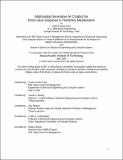Multimodal Generative AI Chatbot for Root Cause Diagnosis in Predictive Maintenance
Author(s)
Lorente Anon, Carla
DownloadThesis PDF (2.709Mb)
Advisor
Boning, Duane S.
Welsch, Roy
Terms of use
Metadata
Show full item recordAbstract
Predictive maintenance plays a critical role in industrial operations by enabling organizations to detect potential equipment failures before they occur. However, while sensor data can identify anomalies such as excessive vibration or temperature fluctuations, technicians often struggle to efficiently diagnose and resolve the root causes of these alarms. This research presents a generative AI-powered chatbot designed to enhance the root cause diagnosis process in predictive maintenance by leveraging multimodal retrieval-augmented generation (RAG) and advanced AI-driven troubleshooting capabilities.
The chatbot integrates multiple functionalities to support maintenance teams in resolving alarms quickly and accurately. Its time series analysis module processes real-time sensor data, identifying abnormal patterns and guiding users through a structured troubleshooting workflow. The retrieval-augmented generation (RAG) engine allows the chatbot to retrieve and synthesize relevant troubleshooting information from technical manuals, historical maintenance records, and structured knowledge bases, ensuring that technicians receive precise, grounded outputs. Additionally, the chatbot supports multimodal interactions, enabling users to upload images, audio, and video for more comprehensive diagnostics. By analyzing uploaded images of damaged components, transcribing spoken maintenance reports, and processing video footage of equipment malfunctions, the chatbot enhances problem identification and resolution.
Another key feature of the chatbot is its interactive guided conversation system, which enables multi-turn dialogues that refine diagnostics dynamically based on technician input. Instead of providing static troubleshooting steps, the chatbot continuously adapts its responses to ensure that users receive the most relevant recommendations as the diagnostic process unfolds. To maintain safety and reliability, the system incorporates AI guardrails, filtering inappropriate or irrelevant inputs while ensuring that generated responses align with best practices for industrial maintenance.
An evaluation framework is proposed to assess the chatbot’s effectiveness, focusing on retrieval accuracy, response relevance, and diagnostic efficiency. Initial results demonstrate approximately 30% reduction in diagnostic time, highlighting the chatbot’s potential to improve maintenance workflows, reduce downtime, and enhance technician productivity. This research underscores the transformative role of multimodal generative AI in predictive maintenance and lays the foundation for broader industrial applications. As a result of this work, a patent has been filed to protect the novel architecture and methods developed. Future work could focus on expanding retrieval capabilities to include video, integrating intelligent task automation for dynamic work order generation, and refining alarm prioritization using adaptive risk-based assessments.
Date issued
2025-05Department
Massachusetts Institute of Technology. Department of Electrical Engineering and Computer Science; Sloan School of ManagementPublisher
Massachusetts Institute of Technology